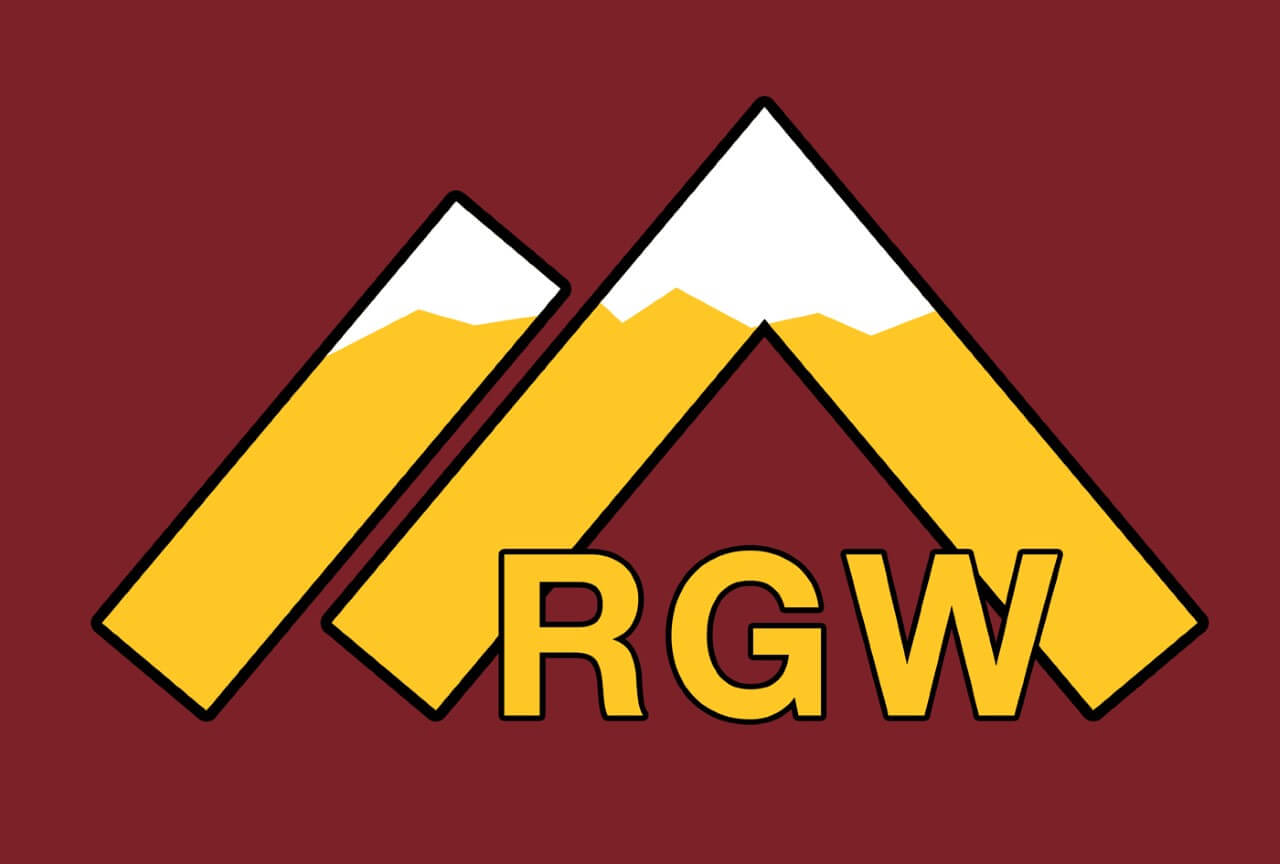Layout Design
The Home and Design of the RGW
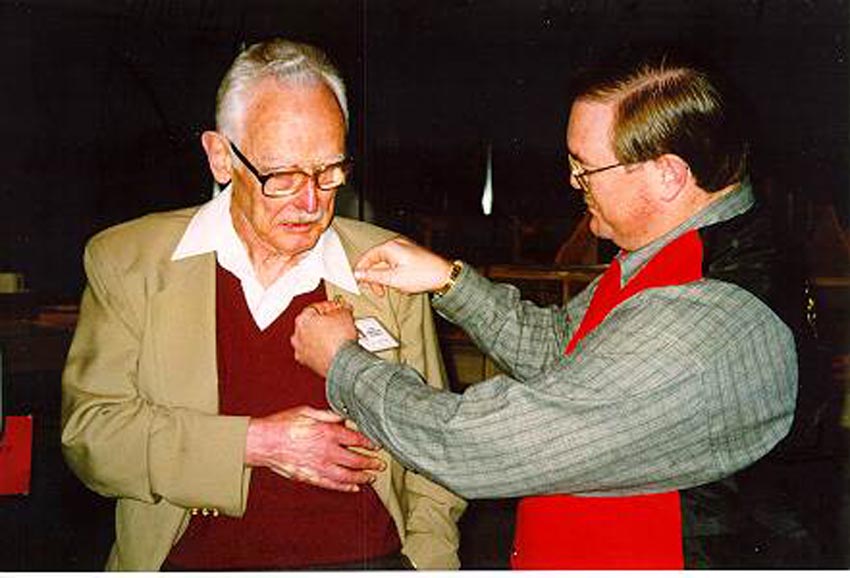
Layout Design
You will find that our design methodology is based on the very rich tradition established by the greatest layout designer of our time, John Armstrong. It was a sincere pleasure to meet him in April of 1998 at the PSMRE layout and a privilege to bestow upon him, honorary membership in the association during his visit (see picture at left).
Following the tradition established by Mr. Armstrong, we started the design of the railroad with our version of Givens & Druthers, an Armstrong method of finding the common ground between your ultimate railroad and your practical railroad. As you can see from my G&D specifications, the RGW is to be a modern railroad, with large diesels as the main motive power and oversize cars being the rule rather than the exception. In addition, the “relative emphasis” category gives you a bit of an insight into my desire that realistic operation is more important on the RGW than is scenic realism. This means it is preferable to have unique industry and switching opportunities as opposed to long runs through areas heavy in scenery. One of the true advantages of a building this size, and with at least two levels of track, you can ultimately have a little bit of both.
Layout Design
You will find that our design methodology is based on the very rich tradition established by the greatest layout designer of our time, John Armstrong. It was a sincere pleasure to meet him in April of 1998 at the PSMRE layout and a privilege to bestow upon him, honorary membership in the association during his visit (see picture at left).
Following the tradition established by Mr. Armstrong, we started the design of the railroad with our version of Givens & Druthers, an Armstrong method of finding the common ground between your ultimate railroad and your practical railroad. As you can see from my G&D specifications, the RGW is to be a modern railroad, with large diesels as the main motive power and oversize cars being the rule rather than the exception. In addition, the “relative emphasis” category gives you a bit of an insight into my desire that realistic operation is more important on the RGW than is scenic realism. This means it is preferable to have unique industry and switching opportunities as opposed to long runs through areas heavy in scenery. One of the true advantages of a building this size, and with at least two levels of track, you can ultimately have a little bit of both.

Current Layout Plans
Level 1 - Staging
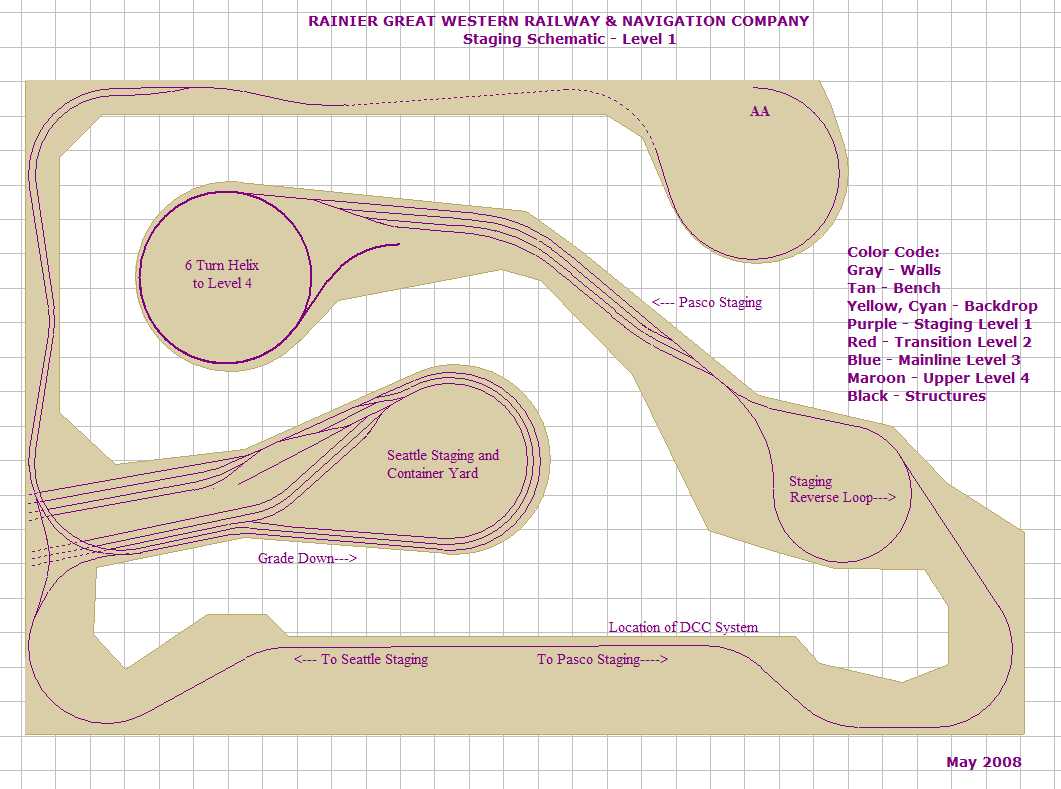
Level 1 - Staging

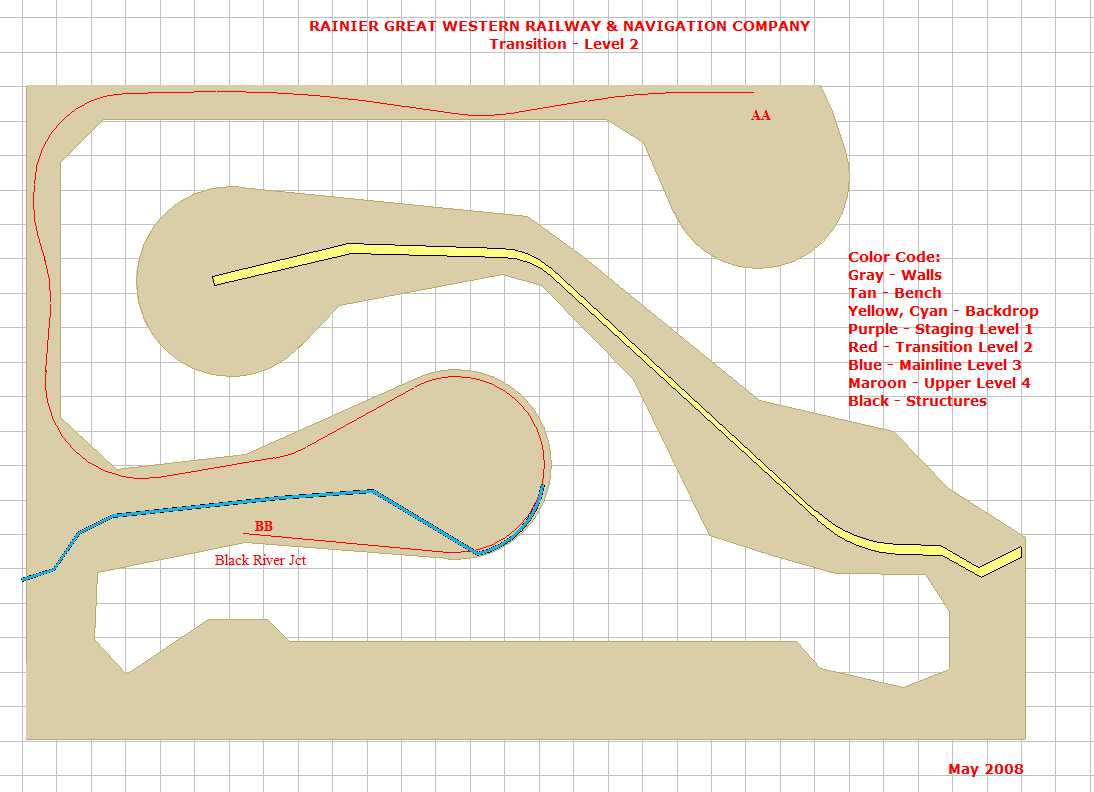
Level 2 - Transition
Very early on in my design, I decided to put to use the design tool CADRAIL. Designed by Sandia Software, CADRAIL is a modified computer aided design program that, once learned, makes the conversion of your design from “minds-eye” to “on paper”, much easier. Sandia has done an excellent job in adding tools that assist the designer. Tools I find especially useful are the auto-align and auto-trim features. These tools allow you to quickly connect figures (lines, curves) together and eliminate the excess. The creation of easements with the use of the fit to tangents tool is also very beneficial. One of the more useful features of CADRAIL is the use of layers. Layers allow you to design different features of the railroad on their own level, then you can select which layers to view. I choose to put layers in categories; some examples include benchwork, electrical, mainline track, hidden staging and the like. I even save one for text, so that I can hide it for design purposes, but show it for descriptive purposes.
Level 2 - Transition
Very early on in my design, I decided to put to use the design tool CADRAIL. Designed by Sandia Software, CADRAIL is a modified computer aided design program that, once learned, makes the conversion of your design from “minds-eye” to “on paper”, much easier. Sandia has done an excellent job in adding tools that assist the designer. Tools I find especially useful are the auto-align and auto-trim features. These tools allow you to quickly connect figures (lines, curves) together and eliminate the excess. The creation of easements with the use of the fit to tangents tool is also very beneficial. One of the more useful features of CADRAIL is the use of layers. Layers allow you to design different features of the railroad on their own level, then you can select which layers to view. I choose to put layers in categories; some examples include benchwork, electrical, mainline track, hidden staging and the like. I even save one for text, so that I can hide it for design purposes, but show it for descriptive purposes.

Level 3 - Main
Following the basic track plan described in the G&D, but since modified to be more functional, our design essentially starts in South Seattle yard then heads south until it reaches Black River Junction just west of Renton, Washington. The RGW takes ownership of the line east of Black River. There are two branches on the main level of the layout; the first runs through Renton, and includes the RGW-owned Renton Yard. It heads east through rural King County, along the Cedar River, turning south at the Old Maple Valley Junction, where the CPSRR (Columbia and Puget Sound RR) actually ran south through Black Diamond to Franklin. There is an interchange with the BNSF at Palmer Junction. BNSF then runs back to staging along newly installed concrete ties to the helix and finally staging. The second branch is a BNSF-owned line that heads north to Maltby, WA. On this line, the RGW serves Boeing and Pacific Car & Foundry as well as other Renton-based industries. There is also an excursion train that runs north to the wineries in Woodinville.
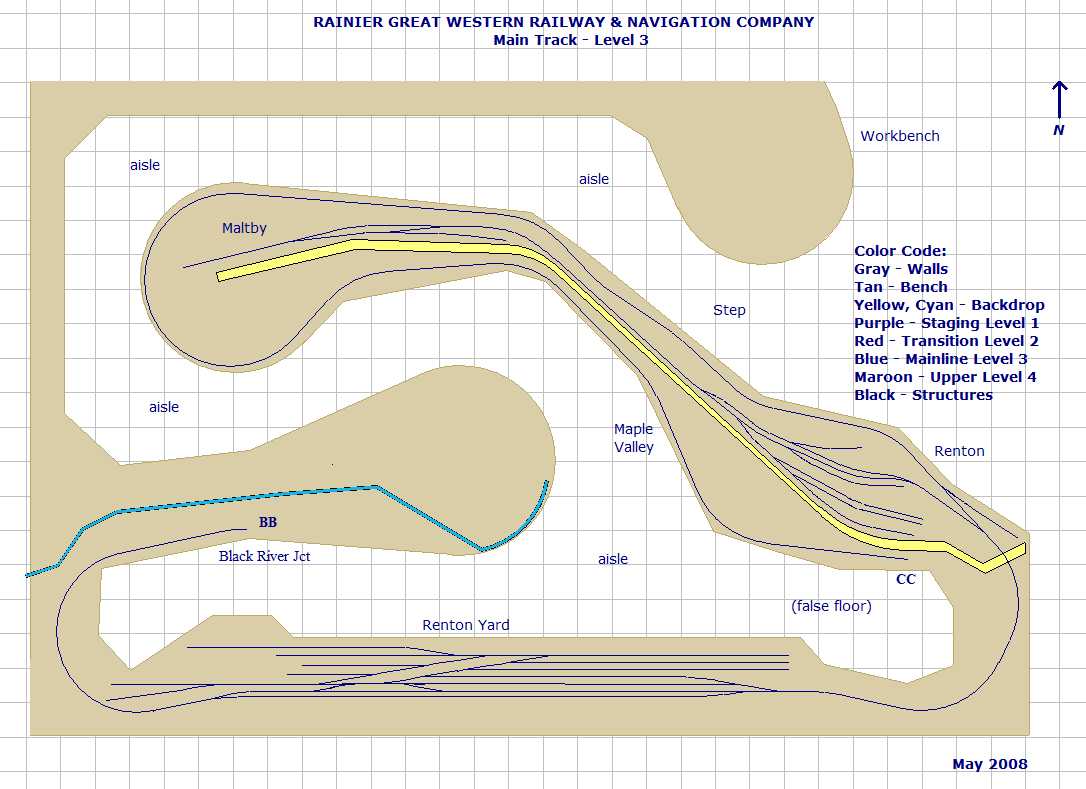
Level 3 - Main
Following the basic track plan described in the G&D, but since modified to be more functional, our design essentially starts in South Seattle yard then heads south until it reaches Black River Junction just west of Renton, Washington. The RGW takes ownership of the line east of Black River. There are two branches on the main level of the layout; the first runs through Renton, and includes the RGW-owned Renton Yard. It heads east through rural King County, along the Cedar River, turning south at the Old Maple Valley Junction, where the CPSRR (Columbia and Puget Sound RR) actually ran south through Black Diamond to Franklin. There is an interchange with the BNSF at Palmer Junction. BNSF then runs back to staging along newly installed concrete ties to the helix and finally staging. The second branch is a BNSF-owned line that heads north to Maltby, WA. On this line, the RGW serves Boeing and Pacific Car & Foundry as well as other Renton-based industries. There is also an excursion train that runs north to the wineries in Woodinville.

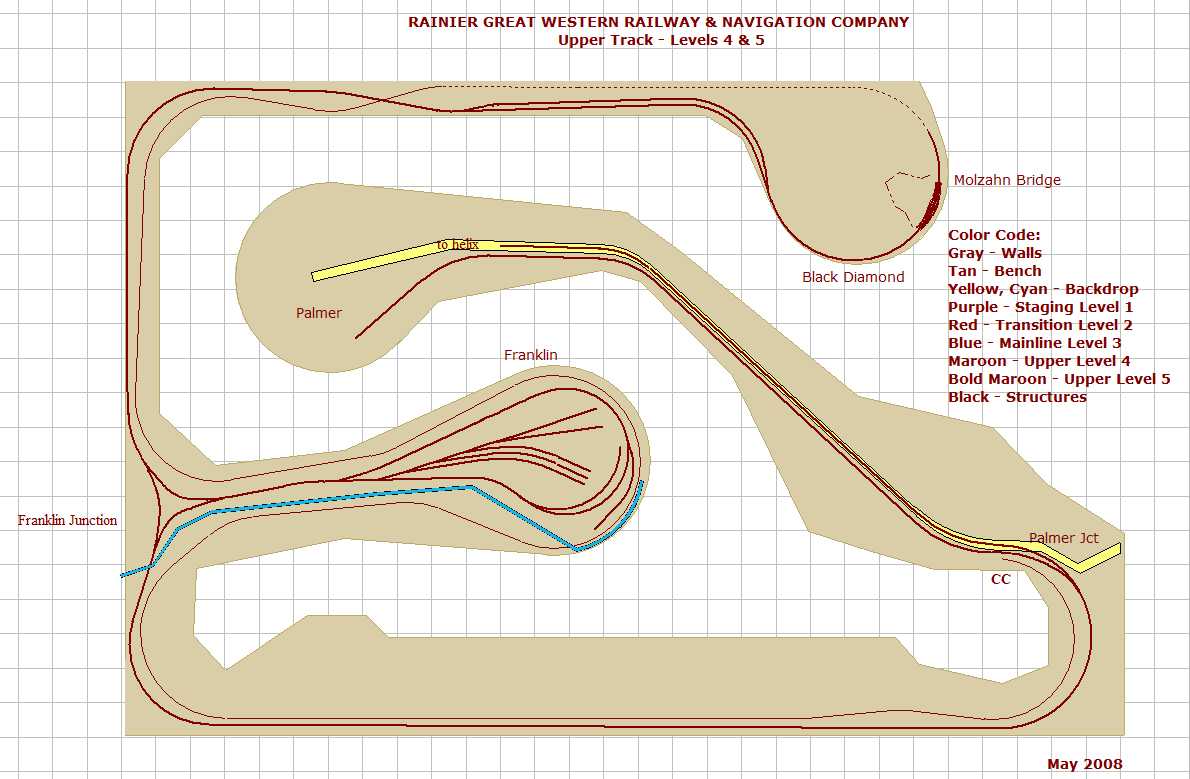
Level 4 - Upper
Our first design in 1996 was put together for a 14 x 25 ft basement room. It ran through a closet and down through an enclosed single track “tunnel” in an adjoining room’s closet. The “tunnel” was enclosed so that the closet could still be used by the kids and not have the trains derail. Once the track became visible, it ran through Black Diamond and then along the wall. There was also a helix in the lower corner that had yet to be completed for a planned second level.
After our move to Black Diamond, we decided to redesign the layout to take advantage of the new space, while still using the basic elements of the first railroad. Our original mainline design (July 2005) makes good use of the room, providing distinct viewing areas with the help of the backdrops. Remember it is a work in process, branch line detail has yet to be put in and no industry trackage is designed. Here is a quick link to our original hidden staging.
Level 4 - Upper
Our first design in 1996 was put together for a 14 x 25 ft basement room. It ran through a closet and down through an enclosed single track “tunnel” in an adjoining room’s closet. The “tunnel” was enclosed so that the closet could still be used by the kids and not have the trains derail. Once the track became visible, it ran through Black Diamond and then along the wall. There was also a helix in the lower corner that had yet to be completed for a planned second level.
After our move to Black Diamond, we decided to redesign the layout to take advantage of the new space, while still using the basic elements of the first railroad. Our original mainline design (July 2005) makes good use of the room, providing distinct viewing areas with the help of the backdrops. Remember it is a work in process, branch line detail has yet to be put in and no industry trackage is designed. Here is a quick link to our original hidden staging.

